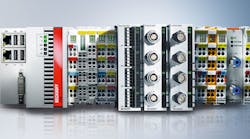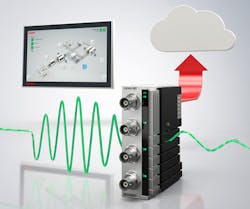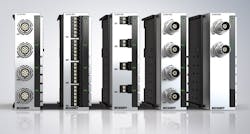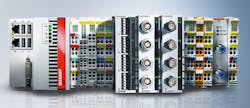As technologies advance and gain wide adoption, they become less expensive over time and inevitably become a necessity rather than a luxury. Consider consumer technology, for instance: The U.S. Bureau of Labor and Statistics notes that software prices decreased by nearly two-thirds from 1997 to 2015 and personal computer (PC) prices dropped roughly 90% over the same period. The industrial technology market is now reaching a similar tipping point with high-end measurement solutions.
With new, lower-cost I/O modules for measurement applications, machine builders and smart factories alike can harness the ever-increasing benefits that high-end measurement offers. General production machines, for example, require measurement of many key metrics, including temperature, vibration, pressure, material thickness, and weight measurement, among others. Gathering process data allows engineers to better enhance machine performance, predict developing faults or failures, schedule maintenance services, and analyze production across entire lines or plants in the cloud.
High-end measurement boosts manufacturing on top of research
EtherCAT-based measurement technology uses oversampling, distributed clocks, and timestamps to provide better process data for enhancing machine performance, scheduling maintenance, and comparing production across entire lines or plants in the cloud.
Although high-end measurement technology is most commonly associated with research and development or lab environments, it is just as valuable in production machinery. These I/O modules provide serious benefits for factories that must keep machines running around the clock with minimal downtime while acquiring and filtering massive amounts of data to glean insights in real-time. This benefits the local machines, and it is also crucial for multisite IIoT strategies.
The price point of previous black box options for high-end measurement limited its adoption in the industrial market. However, as measurement requirements reach more applications, the equipment becomes more necessary in the engineering toolkits of manufacturers to remain competitive.
What powers high-end measurement?
Today, system-integrated I/O modules with high-end measurement technology are able to provide a measurement accuracy of 100 ppm at 23°C and 24-bit resolution with up to 50,000 samples per second. At this accuracy, even the smallest deviation in performance immediately prompts corrective action, and low temperature drift ensures predictable error limits across long machine lines. This is possible through the fundamentals of EtherCAT-based measurement technology, which takes advantage of features such as distributed clocks, oversampling, and timestamps.
- Distributed clocks rely on a local clock built into all Beckhoff EtherCAT devices. These synchronize automatically and continuously with all distributed clocks on a standard time base. This provides precise synchronization of less than 1µs among all devices. It also compensates for different communication runtimes and minimizes the deviation between clocks to less than 100 nanoseconds. Achieving the absolute minimum response time, deterministic actual value acquisition, and deterministic set value output is possible through distributed clocks.
- Oversampling functionality within EtherCAT measurement modules is also triggered by the local clocks. The built-in oversampling functionality enables the transmission of process data to the controller more than once per communication cycle. Oversampling repeatedly samples process data by a set factor within a communication cycle to achieve the higher resolution. Numerous functions are enabled as a result, including fast signal monitoring within a dynamic machine control system, signal sampling independent of cycle time, and fast loop control, among others. Even with moderate communication cycle times, 200-kHz sampling rates are possible.
- Timestamping is the final fundamental of EtherCAT that is necessary for high-end measurement. Measurement data types contain timestamps in addition to user data in order to pinpoint when important events, such as energy spikes, occurred with maximum precision. In addition, timestamps make it possible to trigger precise outputs independent of the cycle time.
These EtherCAT fundamentals—timestamps, oversampling, and distributed clocks—are crucial for achieving quality high-end measurement. However, to choose the best module for the application, engineers must consider many other aspects, including system-integrated diagnostics, filters, scaling features, and form factors.
Enhanced toolset boosts measurement technology
The growing range of options and more competitive price points make high-end measurement a necessity for all machine control applications, not just test bench settings.
As price points continue to drop and high-end measurement is adopted more in machine building applications, the options for these modules continue to grow. These now encompass a range of important features, including free scaling. Unlike previous solutions, I/O modules that offer free scaling permit the scaling of each individual channel, thereby maximizing flexibility.
Measurement modules are available for various signal types, including voltage measurements of 20 mV to 30 V and current measurement with selectable ranges from −20/0/4 to ±20mA. Other options include Integrated Electronics Piezo-Electric (IEPE) measurement, which is mainly used for vibration analysis, and strain gauge with half, full and quarter bridges. The extended range capability of the measurement hardware makes it possible to measure up to 107% of the measuring range.
Carefully selected I/O components with high stability, robust EMC protection circuitry, and proven design provide reliable inputs for the highest-quality demands. The modules should also offer multiple connector options, such as push-in, LEMO, and BNC, for connecting a wide range of field devices.
Built-in diagnostics and filtering improve measurement results
Today’s evolving smart factories are engineered to gather as much data as possible when monitoring production machines. However, not all measured data are worthwhile, and malfunctions in the system can create errant signals that throw off analyses. High-quality measurement I/O modules should support free scaling and eliminate bad data through filtering.
To ensure effective signal monitoring, efficient calculations are possible directly in the I/O terminal. Onboard filters can include, among others, FIR up to the 39th order, IIR up to the 6th order, or self-defined filters using coefficients. Operators can configure these via standard control software and change them during runtime. In addition, custom filters, such as Chebyshev and Butterworth, can be designed using filter design software tools, which provide a graphical engineering interface. These can be transferred into the I/O terminal and used in the PLC logic as part of PC-based automation software.
System-integrated measurement modules are also able to check for broken wires, short circuits, abnormal internal voltages, temperature spikes, and so on, and send all information to the machine controller via a standard I/O system. Internal self-test functions provide improved operating and measurement reliability. This means the controls engineer can enhance machine functionality before performing any analysis locally, either at the edge or in the cloud.
Form factor should follow functionality
High-end measurement modules that are compact and DIN rail-mountable can connect directly with standard machine controllers and I/O systems.
Despite the advanced features, high-level measurement hardware cannot take up excessive space or require unnecessary modifications in control cabinets. Traditional black box measurement hardware is notoriously standalone, operating in its own isolated hardware, software, and networking layer. To avoid this, look for compact, DIN rail-mountable units with metal housings, which provide optimum heat dissipation and directly connect with standard machine controllers and I/O systems.
Often, two- and four-channel I/O versions are available, and each channel can be individually parameterized. This channel-oriented thinking promotes flexible handling of separate process data feeds and ensures synchronous scanning throughout the system.
When examining high-end measurement technology options, be aware of available built-in filters and diagnostics and select components with a form factor that integrates with the machine control platform. Clearly, changes in machines’ behavior can create performance issues, and modern I/O systems with integrated high-end measurement technology can keep track of all machines in a system even in complex cases. This empowers machine builders and end-users to maximize efficiencies in today’s competitive, cloud-connected manufacturing environment. As price points continue to drop, high-end measurement modules will become even more necessary for installation directly in the machine control platform.
Sree Potluri is an I/O application specialist at Beckhoff Automation.












